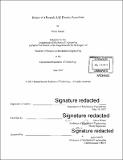| dc.contributor.advisor | Amos Winter. | en_US |
| dc.contributor.author | Wanek, Brian (Brian J.) | en_US |
| dc.contributor.other | Massachusetts Institute of Technology. Department of Mechanical Engineering. | en_US |
| dc.date.accessioned | 2017-12-05T19:17:08Z | |
| dc.date.available | 2017-12-05T19:17:08Z | |
| dc.date.copyright | 2017 | en_US |
| dc.date.issued | 2017 | en_US |
| dc.identifier.uri | http://hdl.handle.net/1721.1/112533 | |
| dc.description | Thesis: S.B., Massachusetts Institute of Technology, Department of Mechanical Engineering, 2017. | en_US |
| dc.description | Cataloged from PDF version of thesis. | en_US |
| dc.description | Includes bibliographical references (page 21). | en_US |
| dc.description.abstract | The design requirements for the new electric powertrain were the ability to deliver the peak power of 80kw allowed by rules and meet the mass goal of 23kg. Rear wheel independence needed to be maintained either through a multi-motor design or a differential, but with vehicle performance in mind. Stiffness of the mounting system was another goal, as the previous design had lateral deflections larger than deemed acceptable. Along with system design requirements, various components and packaging options were considered. Preliminary design and estimation coupled with fundamental engineering rational focused the design to a particular setup. In parallel with system design, analysis was performed to select materials, geometry, bearings, and hardware. Load cases were analyzed to determine how FEA simulations would be set up. Failure modes checked were primarily yield conditions, but stiffness of the mounting plates was also analyzed to ensure the system met the max deflection goal of 0.005". The final design included a single three phase electric motor capable of up to 100kW peak with a limited slip differential, and a mass reduction of almost 45% over the previous powertrain, meeting the mass goal. Eccentric rings allow for easy chain tensioning. A simple 6 bolt mounting system makes the self-contained unit easy to remove from the frame, and overall stiffness is improved from the previous design. | en_US |
| dc.description.statementofresponsibility | by Brian Wanek. | en_US |
| dc.format.extent | 21 pages | en_US |
| dc.language.iso | eng | en_US |
| dc.publisher | Massachusetts Institute of Technology | en_US |
| dc.rights | MIT theses are protected by copyright. They may be viewed, downloaded, or printed from this source but further reproduction or distribution in any format is prohibited without written permission. | en_US |
| dc.rights.uri | http://dspace.mit.edu/handle/1721.1/7582 | en_US |
| dc.subject | Mechanical Engineering. | en_US |
| dc.title | Design of a Formula SAE electric powertrain | en_US |
| dc.title.alternative | Design of a FSAE electric powertrain | en_US |
| dc.title.alternative | Design of a Formula Society of Automotive Engineers electric powertrain | en_US |
| dc.type | Thesis | en_US |
| dc.description.degree | S.B. | en_US |
| dc.contributor.department | Massachusetts Institute of Technology. Department of Mechanical Engineering | |
| dc.identifier.oclc | 1012940134 | en_US |
